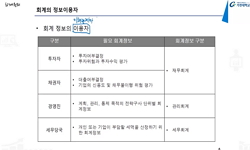[연구목적] 본 연구는 내부자거래에 관한 선행연구를 확장하여 내부자의 지위(CEO vs non-CEO), 거래 유형(내부자매도, 내무자매수) 별로 기업의 미공개주요정보(성과 전망)에 대한 이용 정도에...
http://chineseinput.net/에서 pinyin(병음)방식으로 중국어를 변환할 수 있습니다.
변환된 중국어를 복사하여 사용하시면 됩니다.
- 中文 을 입력하시려면 zhongwen을 입력하시고 space를누르시면됩니다.
- 北京 을 입력하시려면 beijing을 입력하시고 space를 누르시면 됩니다.
https://www.riss.kr/link?id=A109661991
- 저자
- 발행기관
- 학술지명
- 권호사항
-
발행연도
2025
-
작성언어
-
- 주제어
-
KDC
320
-
등재정보
KCI등재
-
자료형태
학술저널
-
수록면
83-112(30쪽)
- 제공처
-
0
상세조회 -
0
다운로드
부가정보
국문 초록 (Abstract)
[연구방법] 2011년부터 2018년까지 분석기간에 코스피 및 코스닥 상장 기업이 공시한“임원 등의 특정증권등 소유상황 보고서” 정보를 수집하여 거래시점에 공개되지 않은분기결산 정보와의 관련성을 회귀분석을 통하여 살펴보았다. 내부자거래의 특성을 반영하여 분석기간 개시 시점 이후 상장 폐지 기업은 상장 폐지 이전 시점까지 관측치를 표본에 포함하여 분석하였으며, 실증분석 결과의 신뢰성을 높이기 위하여 복수의 내부자거래 변수의 측정 방법 및 표본의 선정기준을 이용하였다.
[연구결과] 첫째, 내부자는 외부자와 달리 특정주식 등 거래에 미공개 성과정보를 매우 체계적으로 이용하며 특히, 매수거래보다 매도거래에서 기업의 미공개 성과정보를더욱 많이 이용하고 있는 것으로 나타났다. 둘째, 내부자 수준별로 CEO인 내부자보다non-CEO인 내부자가 미공개 성과정보를 더욱 많이 이용하고 있는 것으로 나타났다. 셋째, 내부자는 적시적인(분기) 내부 성과정보에 대한 접근성을 가지고 있으며, 주로매출액의 증감정보를 내부거래에 활용하는 것으로 나타났다.
[연구의 시사점] 본 연구 결과는 기존의 내부자거래 규제가 효과적으로 작동하지 못하여 자본시장의 공정성을 중요하게 훼손하였음을 보여주며, 관련 규제의 효율성과 효과성을 높이기 위해서는 매도거래 및 non-CEO인 임원에 대한 내부자거래 제한 및 모니터링에 더욱 초점을 맞추어야 함을 시사한다.
[연구목적] 본 연구는 내부자거래에 관한 선행연구를 확장하여 내부자의 지위(CEO vs non-CEO), 거래 유형(내부자매도, 내무자매수) 별로 기업의 미공개주요정보(성과 전망)에 대한 이용 정도에 차이가 있는지 알아본다. 또한 성과정보의 산출 단계(매출액, 매출총이익, 영업이익, 당기순이익)별로 내부자거래 미공개정보 이용에 차이가 있는지알아본다.
[연구방법] 2011년부터 2018년까지 분석기간에 코스피 및 코스닥 상장 기업이 공시한“임원 등의 특정증권등 소유상황 보고서” 정보를 수집하여 거래시점에 공개되지 않은분기결산 정보와의 관련성을 회귀분석을 통하여 살펴보았다. 내부자거래의 특성을 반영하여 분석기간 개시 시점 이후 상장 폐지 기업은 상장 폐지 이전 시점까지 관측치를 표본에 포함하여 분석하였으며, 실증분석 결과의 신뢰성을 높이기 위하여 복수의 내부자거래 변수의 측정 방법 및 표본의 선정기준을 이용하였다.
[연구결과] 첫째, 내부자는 외부자와 달리 특정주식 등 거래에 미공개 성과정보를 매우 체계적으로 이용하며 특히, 매수거래보다 매도거래에서 기업의 미공개 성과정보를더욱 많이 이용하고 있는 것으로 나타났다. 둘째, 내부자 수준별로 CEO인 내부자보다non-CEO인 내부자가 미공개 성과정보를 더욱 많이 이용하고 있는 것으로 나타났다. 셋째, 내부자는 적시적인(분기) 내부 성과정보에 대한 접근성을 가지고 있으며, 주로매출액의 증감정보를 내부거래에 활용하는 것으로 나타났다.
[연구의 시사점] 본 연구 결과는 기존의 내부자거래 규제가 효과적으로 작동하지 못하여 자본시장의 공정성을 중요하게 훼손하였음을 보여주며, 관련 규제의 효율성과 효과성을 높이기 위해서는 매도거래 및 non-CEO인 임원에 대한 내부자거래 제한 및 모니터링에 더욱 초점을 맞추어야 함을 시사한다.
다국어 초록 (Multilingual Abstract)
[Methodology] A regression analysis was conducted using collected share change data from DART. This study analyses companies listed on and delisted from the KOSPI and KOSDAQ markets from 2011 to 2018. To enhance the reliability of the empirical results, multiple methods for measuring insider trading variables and criteria for sample selection were utilized.
[Findings] First, unlike external parties, insiders systematically utilize nonpublic both revenue and profit information in trading, especially, in selling compared to buying. Second, non-CEOs utilize nonpublic performance information more extensively than CEOs. Third, insiders have timely access to internal performance information and primarily use changes in revenue information for their insider trading activities.
[Implications] To enhance the efficiency and effectiveness of these regulations, the study highlights the need to place greater focus on restricting and monitoring insider trading, particularly in sell transactions and among non-CEO executives.
[Purpose] This study examines whether there are differences in the extent of the use of material nonpublic information based on the position of insiders transaction types, and different performance information. [Methodology] A regression analysis was ...
[Purpose] This study examines whether there are differences in the extent of the use of material nonpublic information based on the position of insiders transaction types, and different performance information.
[Methodology] A regression analysis was conducted using collected share change data from DART. This study analyses companies listed on and delisted from the KOSPI and KOSDAQ markets from 2011 to 2018. To enhance the reliability of the empirical results, multiple methods for measuring insider trading variables and criteria for sample selection were utilized.
[Findings] First, unlike external parties, insiders systematically utilize nonpublic both revenue and profit information in trading, especially, in selling compared to buying. Second, non-CEOs utilize nonpublic performance information more extensively than CEOs. Third, insiders have timely access to internal performance information and primarily use changes in revenue information for their insider trading activities.
[Implications] To enhance the efficiency and effectiveness of these regulations, the study highlights the need to place greater focus on restricting and monitoring insider trading, particularly in sell transactions and among non-CEO executives.
동일학술지(권/호) 다른 논문
-
중국 상장기업의 기업지배구조와 기업수명주기가 이익조정에 미치는 영향
- 한국회계정보학회
- 방이이(Yi-Yi Pang)
- 2025
- KCI등재
-
- 한국회계정보학회
- 김달곤(Dalgon Kim)
- 2025
- KCI등재
-
ESG 활동이 기업 회계적 성과에 미치는 영향 : 텍스트 마이닝을 통한 지속가능경영보고서 분석을 중심으로
- 한국회계정보학회
- 정연승(Yeonseung Jeong)
- 2025
- KCI등재
-
온실가스 검증의견서 인증이 자기자본비용에 미치는 영향에 대한 연구
- 한국회계정보학회
- 임욱빈(WookBin Leem)
- 2025
- KCI등재





 스콜라
스콜라


